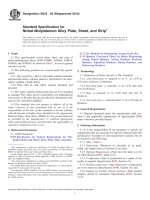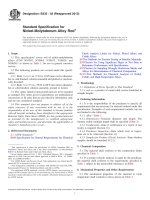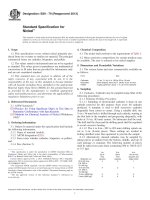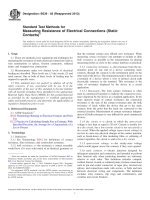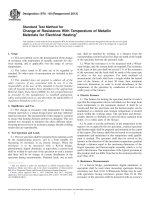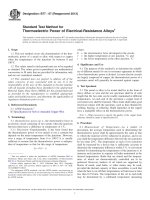Astm b 114 07 (2013)
Bạn đang xem bản rút gọn của tài liệu. Xem và tải ngay bản đầy đủ của tài liệu tại đây (146.41 KB, 5 trang )
Designation: B114 − 07 (Reapproved 2013)
Standard Test Method for
Temperature-Resistance Constants of Sheet Materials for
Shunts and Precision Resistors1
This standard is issued under the fixed designation B114; the number immediately following the designation indicates the year of
original adoption or, in the case of revision, the year of last revision. A number in parentheses indicates the year of last reapproval. A
superscript epsilon (´) indicates an editorial change since the last revision or reapproval.
1. Scope
4. Test Specimen
1.1 This test method covers the determination of the change
of resistance with temperature of sheet materials used for
shunts and precision resistors for electrical apparatus. It is
applicable to materials normally used in the temperature range
of from 0 to 80°C.
4.1 The test specimen shall be of such dimensions that its
electrical resistance can be measured to the required accuracy.
NOTE 1—Measurements are simplified if the specimen has a resistance
of 0.01 Ω or more. The specimen may be bent in the form of a “U” to
facilitate handling.
1.2 The values stated in inch-pound units are to be regarded
as the standard. The metric equivalents of inch-pound units
may be approximate.
1.3 This standard does not purport to address all of the
safety concerns, if any, associated with its use. It is the
responsibility of the user of this standard to become familiar
with all hazards including those identified in the appropriate
Material Safety Data Sheet (MSDS) for this product/material
as provided by the manufacturer, to establish appropriate
safety and health practices, and determine the applicability of
regulatory limitations prior to use.
5. Terminals
5.1 A current terminal shall be attached to each end of the
specimen. These terminals shall be either soldered or clamped
in such a manner that there will be no change of current
distribution in the specimen during the test.
5.2 Potential terminals, one at each end, shall be located at
a distance not less than two times the width of the specimen
from the current terminals. These terminals shall be attached at
the center of the width of the specimen either by soldering to
ears cut out of the specimen (Note 2) as shown in Fig. 1 or by
clamps, each of which presses a single sharp point into the
material.
2. Referenced Documents
2.1 ASTM Standards:2
B84 Test Method for Temperature-Resistance Constants of
Alloy Wires for Precision Resistors
NOTE 2—The ears shall be cut so that they are about 1⁄2 in. (12.7 mm)
in length and 1⁄8 in. (3.2 mm) in width. The cut shall be clean and free from
slivers at the junction of the ear and the specimen. Before cutting the ears,
it is desirable to drill two small holes with a sharp drill where the ear will
be jointed to the specimen.
3. Significance and Use
3.1 This test method covers the determination of the change
of resistance with temperature for precision resistors and
shunts made from sheet materials.
6. Preliminary Treatment for Manganin Samples
6.1 In the case of manganin materials, after all the mechanical work has been finished, the specimen shall be given one
heat treatment of 48 h at 140 6 5.0°C and then cooled to room
temperature.
3.2 Materials normally used in the temperature range from 0
to 80°C may be tested using this test method.
6.2 The specimen shall then be given a dip in a nitric acid
solution (50 %) to remove the copper film (which can be
judged by the color of the specimen) and then thoroughly
scrubbed in running water.
1
This test method is under the jurisdiction of ASTM Committee B02 on
Nonferrous Metals and Alloys and is the direct responsibility of Subcommittee
B02.10 on Thermostat Metals and Electrical Resistance Heating Materials.
Current edition approved May 1, 2013. Published May 2013. Originally
approved in 1938. Last previous edition approved in 2007 as B114 – 07. DOI:
10.1520/B0114-07R13.
2
For referenced ASTM standards, visit the ASTM website, www.astm.org, or
contact ASTM Customer Service at For Annual Book of ASTM
Standards volume information, refer to the standard’s Document Summary page on
the ASTM website.
7. Apparatus
7.1 The apparatus for making the test shall consist of one or
more baths for maintaining the specimen at the desired
Copyright © ASTM International, 100 Barr Harbor Drive, PO Box C700, West Conshohocken, PA 19428-2959. United States
1
B114 − 07 (2013)
appreciable errors in the results. With apparatus of good
quality, a change of 1°C in its temperature is allowable.
10.3 The test current shall not be of such a magnitude as to
produce an appreciable change in resistance of the specimen or
measuring apparatus due to the heating effect. The dimensions
of the specimen should be such that the power dissipated shall
not exceed 0.02 W/in.2 (0.003 W/cm2) of exposed surface. To
determine experimentally that the test current is not too large,
the specimen may be immersed in a bath having a temperature
at which it has been found that the sheet has a relatively large
change in resistance with temperature. The test current shall be
applied and maintained until the resistance of the specimen has
become constant. The current shall then be increased by 40 %
and maintained at this value until the resistance has again
become constant. If the change in resistance is greater than
0.001 %, the test current is too large and shall be reduced until
the foregoing limitation is reached.
10.4 The measurements shall be made in such a way that the
effects of thermoelectromotive forces and parasitic currents are
avoided. When these effects are small, the resistance of the
specimen when measured by a Kelvin bridge may be obtained
by either of two methods. In the first method, the galvanometer
zero shall be obtained with the galvanometer key open. The
bridge shall be balanced both with the direct and reversed
connection of the battery, the average value of the two results
being the resistance of the specimen. In the second method, the
zero of the galvanometer shall be obtained with the galvanometer key closed and the battery key open. A single balance of
the bridge is then sufficient to obtain the resistance of the
specimen.
FIG. 1 Test Specimen Showing Terminal Connections
temperature, thermometers for measuring the temperatures of
the baths, and suitable means for measuring the resistance of
the specimen.
8. Baths
8.1 Each bath shall consist of chemically neutral oil. The oil
shall be of such quantity and so well stirred that the temperature in the region occupied by the specimen and the thermometer shall be uniform within 0.2°C for any temperature between
0 and 80°C.
11. Procedure
11.1 Connect the test specimen in the measuring circuit and
submerge entirely in the oil bath. For a check on the constancy
of the specimen, make an initial resistance measurement at
room temperature. Raise the temperature of the oil bath or
transfer the specimen to a bath maintained constant at the
highest temperature at which measurements are to be made.
When the test specimen has attained a constant resistance,
record the reading of the measuring device and the temperature
of the bath.
8.2 In an automatically controlled bath, the temperature of
the bath at any time during the test at any temperature level
shall not differ from its mean temperature by more than 0.2°C.
In a manually controlled bath, the rate of change of temperature shall not exceed 0.2°C/min.
9. Temperature Measurement
11.2 Decrease the temperature of the test specimen to the
next lower temperatures either by cooling the bath and maintaining it constant at the next lower temperature, or by
removing the specimen to another bath maintained at the lower
temperature. When the resistance of the specimen has become
constant, again make observations of resistance and temperature.
9.1 The temperature shall be measured by a calibrated
temperature measuring device of suitable precision and accuracy. The thermometer shall have sufficient sensitivity to
indicate temperature changes of 0.1°C. It shall be sufficiently
accurate to measure temperature differences to 0.2°C in the
range from 0 to 80°C.
11.3 In this manner make a series of determinations of the
change of resistance with temperature for the desired descending temperature range.
10. Resistance Measurements
10.1 The change of resistance of the specimen shall be
measured by apparatus capable of determining such changes to
0.001 % of the resistance of the specimen. A Kelvin double
bridge, digital ohmmeter, or equivalent is suitable for this
purpose (see Appendix X1).
11.4 Take measurements at a sufficient number of temperatures to determine the characteristics of the material. In order to
calculate a resistance-temperature equation, tests at three
temperatures are required. If an independent check is to be
made, make observations of at least five temperatures. For
plotting a curve, six or more observations are generally made.
10.2 The temperature of the measuring apparatus shall not
change during the test by an amount sufficient to introduce
2
B114 − 07 (2013)
resistance in ohms per ohm in going from 25°C to t1, and ∆R2
the similar change in going from 25°C to t2. That is:
11.5 Note the temperature of the measuring apparatus at
frequent intervals during the test of each specimen.
12. Resistance-Temperature Equation
(7)
∆R 2 5 ~ R 2 2 R 25! /R 25
(8)
and
12.1 Express the results in terms of the constants in an
equation of the following form:
R t 5 R 25@ 11α ~ t 2 25! 1β ~ t 2 25! 2 #
∆R 1 5 ~ R 1 2 R 25! /R 25
(1)
Then
where:
Rt
α 5 ~ ∆R 2 2 K 2 ∆R 1 ! /K ~ K11 ! ∆t
= resistance of the specimen in ohms at temperature,
°C, t,
= resistance of the specimen in ohms at the standard
R25
temperature of 25°C,
t
= temperature of specimen, °C, and
α and β = temperature-resistance constants of the material.
Temperature of maximum or minimum resistance
= 25°C − (α ⁄2β)
β 5 ~ K∆R 1 1∆R 2 ! /K ~ K11 !~ ∆t !
(10)
If K = 1, this simplifies to:
α 5 ~ ∆R 2 2 ∆R 1 ! /2∆t
(11)
2
(12)
β 5 ~ ∆R 1 1∆R 2 ! /1 ~ ∆t !
NOTE 5—A useful alternative method of calculation is presented as
follows: The resistance-temperature equation is referred to 0°C, and
relative resistance values are used. For example, over the useful range
from 15 to 35°C, the resistance-temperature curve of manganin is
parabolic and of the form:
NOTE 3—This equation will yield either a maximum or a minimum,
depending on which exists in the temperature range in question. However,
this equation is normally used for those alloys such as manganin, having
a temperature-resistance curve approximating a parabola with a maximum
near room temperature.
P t 5 P 0 1At1Bt2
where:
Pt = ratio of the resistance of
resistance of the standard
P0 = ratio of the resistance of
resistance of the standard
13. Calculation of Constants
13.1 The values of α, β, and R25 may be determined by
selecting the measured values of Rt at three well-separated
temperatures, inserting the values of Rt and t in the preceding
section equation to form three equations, and solving simultaneously the three equations for R25, α, and β.
(13)
the specimen at t °C to the
resistor at 25°C,% ,
the specimen at 0°C to the
resistor at 25°C, %, and
A and B are constants calculated from resistance measurements made at different temperatures. One method of measurement used in production testing is to compare the resistance of
the test sample to that of a stable resistor of known characteristics maintained at reference temperature 25°C. The resistance
is approximately the same as the test sample and measurements
usually are made directly in percentages (for example,
100.008 %). If measurements are made at four temperatures t1,
t2, t3, and t4 between 15 and 35°C, and the corresponding ratios
of test sample resistance to standard resistor are measured in
percentages as P1, P2, P3, and P4, then the constants A and B,
the peak temperature, and temperature coefficient may be
calculated from the following equations:
13.2 When the measurements have not been made at exactly
25°C, or at other suitable temperatures, the calculation may be
simplified by plotting a curve from the observed values of
resistance and temperature, from which curve R25 may be read
directly. Two additional points may then be selected on the
curve, preferably one at t1, at least 5°C below the reference
temperature of 25°C, and a second temperature, t2 near the
highest temperature measured but satisfying the following
relation:
K ~ 25 2 t 1 ! 5 t 2 2 25 5 K∆t
(9)
2
(2)
A5
where K is, for ease of calculation, generally taken as an
integer.
F
1 P3 2 P1 P2 2 P1
1
2 ~ t 3 1t r 12t 1 !
2 t3 2 t1
t4 2 t1
P2 2 P1
P3 2 P1 P4 2 P1
1
22
t3 2 t1
t4 2 t1
t2 2 t1
B5
t 3 1t 4 2 2t 2
NOTE 4—Example—If t1 is 10°C below the reference temperature then
t2 should be 10 or 20 or 30°C etc., above the reference temperature for
greatest ease of calculation, so that K = 1 or 2 or 3, respectively.
G
(14)
(15)
The peak temperature is − (A/2B) and the temperature coefficient between temperature t and the peak temperature in percent per degree Celsius is (A + 2Bt)/2. Then
13.3 If R1 is the resistance at the temperature t1, and R2 is
the resistance at the temperature t2, then:
α 5 @ ~ R 2 2 R 25! 2 K 2 ~ R 1 2 R 25! # /R 25K ~ K11 ! ∆t
(3)
α 5 ~ A150B ! /100
(16)
β 5 @ K ~ R 1 2 R 25! 1 ~ R 2 2 R 25! # /R 25K ~ K11 !~ ∆t ! 2
(4)
β 5 B/100
(17)
If K = 1, this simplifies to:
14. Report
α 5 ~ R 2 2 R 1 ! /2 R 25∆t
(5)
β 5 ~ R 1 1R 2 2 2R 25! /2R 25~ ∆t ! 2
(6)
14.1 Report the following information:
14.1.1 Identification of specimen,
14.1.2 Description of material,
14.1.3 Total length of specimen,
14.1.4 Approximate resistance and distance between potential terminals,
If, instead of measuring the actual resistances at the different
temperatures, the change in resistance relative to the resistance
at 25°C is measured, the above equations take a slightly
different form, as follows: Let ∆R1 represent the change in
3
B114 − 07 (2013)
TABLE 1 Illustrative Form for Reporting Test Data and Calculations
NOTE 1—The following table, with test values inserted for purpose of illustration, is only a suggested form for recording test data and calculations on
temperature-resistance characteristics.
Apparatus
Standard resistor
Ratio coils
Material
Maker
Size
Time
Kelvin bridge for comparing the specimen with standard resistor
No. 38472, 0.0100000 Ω made by Richard Roe
A = 1000; B = 1000
Manganin, Specimen No. 1. From Shipment Received .... Jan. 14, 1937
John Doe
0.020 by 3 by 72 in. Approximate Resistance of Specimen .... 0.01 Ω
RECORD OF TEST
Room
Temperature, °C
Standard
Specimen
Bridge Reading
Minus
Plus
10:00
25.0
25.0
25.0
1000.00
10:30
25.0
25.0
80.2
999.60
10:45
25.0
25.0
65.3
999.81
11:00
25.0
25.0
49.8
999.98
11:15
25.1
25.1
35.1
1000.02
11:30
25.1
25.1
30.0
1000.02
11:45
25.2
25.1
25.0
1000.00
12:00
25.4
25.1
20.2
999.94
12:15
25.5
25.2
15.0
999.88
1:00
25.5
25.3
25.1
1000.00
A
Change in resistance based on the resistance at 25°C.
B
These values are used for checking the stability only. If these values show a change of
should be repeated
(1) Maximum change in resistance, 420 ppm, or 0.042 % between 35 and 80°C.
(2) Curve (see Fig. 2).
(3) Calculation of the constants in the resistance-temperature equation:
Original
Temperature,°C
∆R t × 10−6
25
0
15
−120
65
−180
∆t = 10
K=4
α = + 8.7 × 10−6
β = −0.33 × 10−6
Average α = + 9.6 × 10−6
Average β = −0.33 × 10−6
Temperature for maximum resistance = 25°C − (α ⁄ 2β) = 25°C − ( + 9.6 ⁄ −0.66) = 39.5°C
1000.02
999.62
999.82
999.98
1000.04
1000.02
999.99
999.95
999.88
1000.00
Average
Resistance of
Specimen, Ω
Change in
Resistance,A ppm
1000.01
999.61
999.82
999.98
1000.03
1000.02
1000.00
999.94
999.88
1000.00
0.0100001B
0.0099961
0.0099982
0.0099998
0.0100003
0.0100002
0.0100000
0.0099994
0.0099988
0.0100000B
...
−390
−180
−20
+ 30
+ 20
0
−60
−120
...
more than 0.002 %, then the preliminary treatment prescribed in Section 6
Supplementary
Temperature, °C
25
20
80
∆t=5
K = 11
α = + 10.4 × 10−6
β = −0.32 × 10−6
∆R t × 10−6
0
−60
−390
14.1.5 Tabular list of resistances or changes in resistance
and temperatures in the order taken,
14.1.6 Temperature of measuring apparatus and room at
start and finish of the test,
14.1.7 Temperature of the specimen at which the change of
resistance with temperature is zero (“peak temperature”), if
such occurs within the measured range, and
14.1.8 Results expressed in one of the forms given in
Section 15.
FIG. 2 Temperature-Resistance Curve of Sheet Manganin
(Plotted from Data in Table 1)
15. Record
15.1 The results shall be reported in one of the following
forms and recorded on a data sheet similar to that shown in
Table 1 and Fig. 2.
15.1.1 The maximum percentage change within the temperature range, or
15.1.2 A curve, plotted with temperature as abscissas, and
the percentage or parts per million change in resistance as
ordinates, or
15.1.3 The constants, α, β, etc., in a resistance-temperature
equation may be calculated from the data and recorded as the
constants of the temperature-resistance curve.
16. Precision and Bias
16.1 The instrumentation and operator’s skill play a large
part in the precision and bias attainable. There are no data
available to determine a precision and bias figure for this test
method.
17. Keywords
17.1 resistance change; resistance constants; resistors; sheet
resistors; shunts; temperature coefficient; temperature resistance
4
B114 − 07 (2013)
APPENDIX
(Nonmandatory Information)
X1. THE KELVIN DOUBLE BRIDGE
must be adjusted under three different conditions. These
adjustments may be made in the following order:
X1.1.2.1 With switches S1 and S2 open, balance with double
ratio dials, A and a,
X1.1.2.2 With S1 open and S2 closed, balance by adjusting
the balancing resistor r1, and
X1.1.2.3 With S2 open and S1 closed, adjust r2.
X1.1 There are several methods by which the Kelvin bridge
(Fig. X1.1) may be so balanced that the ratio of the unknown
to the standard is the same as the ratio of the two arms. The
following method is indicated as being a satisfactory method
for specimens having a resistance of 0.01 Ω or more.
X1.1.1 It is important that all the resistances except the ratio
arms shall be kept as small as possible. In particular r1, r2, r3,
and r4 should be less than 0.01 of the resistance of the ratio
arms. The resistance of the connection between X and N should
be less than the sum of X and N.
X1.1.3 This cycle must be repeated until no change in the
double ratio dials is required at the end of the cycle over that
at the beginning.
X1.1.2 The balance is made by a series of approximations.
The two sets of ratio arms, A, B, and a, b, should have the same
values and, whenever adjusted, the two should be adjusted
simultaneously so that at all times A = a and B = b. The bridge
X1.1.4 When the above balances have been obtained the
resistance X of the unknown is represented by the equation:
X 5 N·a/b
However, to determine the effect of temperature it is not
necessary that the value of N should be known, for if b and N
are kept constant and a changed as the resistance of X is
changed because of change in temperature, then the percentage
change in X is the same as the percentage change in a.
X1.1.5 In making the balance the resistors r1 and r2 are
adjusted although these do not in any way enter into the final
equation. Hence, any simple type of adjustable resistor is
entirely satisfactory. In practice many laboratories use merely
a short piece of copper wire, one terminal of which is held
under a binding post. The resistance adjustment is made by
loosening the binding post and sliding the copper wire as
required to increase or decrease the resistance.
FIG. X1.1 Diagram of Kelvin Double Bridge
ASTM International takes no position respecting the validity of any patent rights asserted in connection with any item mentioned
in this standard. Users of this standard are expressly advised that determination of the validity of any such patent rights, and the risk
of infringement of such rights, are entirely their own responsibility.
This standard is subject to revision at any time by the responsible technical committee and must be reviewed every five years and
if not revised, either reapproved or withdrawn. Your comments are invited either for revision of this standard or for additional standards
and should be addressed to ASTM International Headquarters. Your comments will receive careful consideration at a meeting of the
responsible technical committee, which you may attend. If you feel that your comments have not received a fair hearing you should
make your views known to the ASTM Committee on Standards, at the address shown below.
This standard is copyrighted by ASTM International, 100 Barr Harbor Drive, PO Box C700, West Conshohocken, PA 19428-2959,
United States. Individual reprints (single or multiple copies) of this standard may be obtained by contacting ASTM at the above
address or at 610-832-9585 (phone), 610-832-9555 (fax), or (e-mail); or through the ASTM website
(www.astm.org). Permission rights to photocopy the standard may also be secured from the Copyright Clearance Center, 222
Rosewood Drive, Danvers, MA 01923, Tel: (978) 646-2600; />
5

